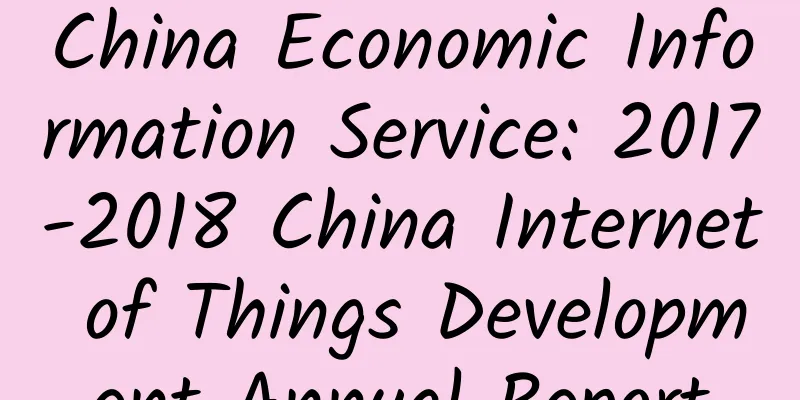China Economic Information Service: 2017-2018 China Internet of Things Development Annual Report

|
The Annual Report analyzed that since 2017, the global IoT market has continued to grow steadily, and cross-border applications have continued to emerge. The scale and diversity of my country's IoT data continue to expand, the industry ecosystem is gradually improving, innovative achievements in sub-sectors continue to emerge, and the development of industrial technology and applications has entered a critical period of implementation. First, the number of IoT devices has exploded globally, and IoT solutions have matured. Since 2017, the scale, penetration rate, and enterprise-level application projects of IoT devices have exploded globally, and IoT solutions have matured. Data shows that in 2017, the number of IoT devices in the world grew strongly, reaching 8.4 billion, exceeding the population for the first time. The global IoT market is expected to achieve large-scale popularization within ten years, and the market size may grow to 3.9-11.1 trillion US dollars by 2025. Second, the scale of my country's Internet of Things market has exceeded one trillion yuan, and the Internet of Things cloud platform has become a core area of competition. In 2017, my country's Internet of Things market gradually returned to rationality and entered a substantial development stage. The annual market scale exceeded 1 trillion yuan, with an annual compound growth rate of more than 25%. Among them, the Internet of Things cloud platform has become a core area of competition. It is expected that my country's Internet of Things platform expenditure will rank first in the world in 2021. Specifically, C-end users (individual users) are more concerned about the actual smart experience brought by Internet of Things devices, while B-end users (industry users/enterprise users) are more concerned about the input-output ratio of Internet of Things applications. Third, the popularity of IoT sub-sectors has differentiated, and technological evolution has driven application products to develop in the direction of intelligence, convenience, and low power consumption. Since 2017, IoT has gradually been verified on a large scale in the fields of transportation, logistics, environmental protection, medical care, security, and electricity. The market segments of "IoT + industry applications" have begun to differentiate, with smart cities, industrial IoT, Internet of Vehicles, and smart homes becoming the four major market segments. The iterative evolution of new IoT-related technologies such as chips, smart identification, sensors, blockchain, and edge computing has accelerated the development of IoT application products in the direction of intelligence, convenience, low power consumption, and miniaturization. Fourth, the revenue of my country's key Internet of Things listed companies reached 483.38 billion yuan, a year-on-year increase of 20.7%, a record high in the past five years. In 2017, the operating income and growth rate of 52 key Internet of Things listed companies in the Shanghai and Shenzhen stock markets and 11 key Internet of Things listed companies in the Hong Kong stock market both hit a record high in the past five years. The trading of concept stocks became more active, the loss was narrowed, the total net profit of enterprises fluctuated and increased, and the overall profitability improved. Data shows that in 2017, the operating income of 52 key listed companies in the Shanghai and Shenzhen stock markets and 11 key listed companies in the Hong Kong stock market reached 483.38 billion yuan and 379.58 billion yuan respectively, a year-on-year increase of 20.7% and 33.4%; the total net profit reached 21.36 billion yuan and 77.88 billion yuan respectively, a year-on-year increase of 24.4% and 91.6%. Fifth, Wuxi continued to deepen the construction of the National Sensor Network Innovation Demonstration Zone, and built and obtained more than 20 national brands related to the Internet of Things. From 2017 to 2018, Wuxi continued to strengthen application pilot demonstrations, improve and perfect the technology innovation system, further refine the roadmap for the development of the Internet of Things industry, and gradually accelerate the integration and development process with the real economy. The "one core, two wings and multiple" industrial structure has emerged. By the end of 2017, Wuxi's Internet of Things business revenue was 243.7 billion yuan, with more than 2,000 Internet of Things companies and more than 2,500 invention patent applications. The Internet of Things projects undertaken by Wuxi covered more than 700 cities in more than 60 countries around the world, including 21 major national application demonstration projects. It took the lead in formulating the international standard "Internet of Things Reference Architecture" and officially mastered the top-level architecture standard. It has built and obtained more than 20 national brands related to the Internet of Things, and its global influence has steadily increased. The Annual Report believes that my country's IoT industry ecosystem is becoming increasingly complete, but there are still some development bottlenecks. The market and industry are not coordinated enough, industry standards are issued by multiple government departments, high-end product R&D capabilities need to be improved, network infrastructure needs to be fully upgraded, and data privacy and security issues are still prominent. The "Annual Report" recommends that my country's Internet of Things industry should increase its R&D investment to enhance original innovation capabilities; consolidate the application foundation of the Internet of Things and promote enterprise transformation and upgrading; promote industrial collaboration and accelerate the development of large-scale application products on the consumer side; actively participate in the formulation of international standards and strengthen research on standard interoperability; clarify security protection ideas and implement them in a classified manner with different focuses. |
<<: Will the mobile phone manufacturers’ launch of customized VR glasses be a hit?
>>: How will smart TVs change the future of home entertainment?
Recommend
Jidu and Hesai Technology reached a strategic cooperation
Jidu is a technology startup dedicated to creatin...
What should I do if my short videos don’t increase my followers? How to attract fans through short videos?
Many short video creators have been complaining t...
GTCI: Global Talent Competitiveness Index Report 2020
GTCI released the "2020 Global Talent Compet...
New media operation: Find hot spots in 3 directions!
I was chatting with a friend recently, and she ta...
Event Operation: How to plan a wonderful membership event?
Normally, we think of event operation as a part o...
The dual face of vivo: conservative in mobile phones, radical in Internet finance
In November 2011, three months after the release ...
When you first enter the workplace, how should you do operations work?
The daily operation of an Internet company is the...
The battle between the two: a game of efficiency
What is the most essential meaning of competition...
What is server hosting used for?
Generally speaking, independent server hosting se...
The room for price increase of China's home appliances from the crazy rise of Moutai
In recent times, the skyrocketing prices of a num...
Taobao's PlayerUnknown's Battlegrounds: Is the launch of "Mini Programs" a counterattack against WeChat or JD.com?
Will Taobao Mobile launch mini programs? This is ...
Case analysis: Analysis of Alipay’s bounty operation activities in December!
Thinking patterns involved in this brief analysis...
What are the reasons for the poor results of Baidu’s bidding promotion?
Customers often visit the official website to inq...
Changba: How to discover, support, produce and retain users?
The mobile KTV application Changba has been in op...









